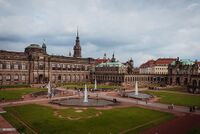Greycott: Difference between revisions
No edit summary |
|||
| Line 156: | Line 156: | ||
==History== | ==History== | ||
==Geography== | ==Geography== | ||
The Greater Hartridge Area is located in the Hartridge | The Greater Hartridge Area is located in the Hartridge Forest Plain, sandwiched between the Southern Coastal Ranges. The forest costal plain isn't flat but quite hilly. The Hartridge Bay is at its widest point 1.5 miles (7.920 feet or 2,414 meters) at its narrowest. The tallest mountain in the Greater Hartridge Area is Mount Baylee which is 5,612 feet (1,710.5 meters) tall. Hartridge is located on the Hartridge Península while it's twin city, Gough City is on the shore. | ||
===Climate=== | ===Climate=== | ||
The climate of Hartridge is Oceanic. With wet rainy conditions all year round. During the summer it is mildly warm and less rainy. Temperatures decline in the autumn and the frequency rain increases. Snow can occur during the months of June through August. Though heavy long-lasting snow is uncommon. Cold waves are common with temperatures reaching 25 degrees F (4 degrees C) on July 15, 2012. The heaviest snowstorm happened on July 14, 2012 when it brought 6.8 in (17 cm) of snow. The coldest high temperature ever recorded was 36 degrees F (2 degrees C) on July 15, 2012. The wet cool spring gives way to summer when heatwaves can take place. With the hottest temperature ever recorded was 86 degrees F (30 degrees C) on January 2, 1997, the warmest overnight temperature was 72 degrees F (22 degrees C) on January 15, 2014. While the city receives a lot of rainfall through the year, the rainiest year was 1984 with 171.4 in (4,354 mm) while the driest year was 1990 with 40.2 in (1,021 mm). The wettest month was July 1999 with 20.8 in (528 mm). The wettest day was August 4, 1955 when 8.4 in (213 mm) of rain fell in 24 hours. The direst month was January 1990 with only 0.9 in (23 mm) rain fell. The snowiest month was July 2012 with 14.1 in (36 cm) of snow fell. The snowiest season was in 1996 with 24 in (61 cm) of snow. | The climate of Hartridge is Oceanic. With wet rainy conditions all year round. During the summer it is mildly warm and less rainy. Temperatures decline in the autumn and the frequency rain increases. Snow can occur during the months of June through August. Though heavy long-lasting snow is uncommon. Cold waves are common with temperatures reaching 25 degrees F (4 degrees C) on July 15, 2012. The heaviest snowstorm happened on July 14, 2012 when it brought 6.8 in (17 cm) of snow. The coldest high temperature ever recorded was 36 degrees F (2 degrees C) on July 15, 2012. The wet cool spring gives way to summer when heatwaves can take place. With the hottest temperature ever recorded was 86 degrees F (30 degrees C) on January 2, 1997, the warmest overnight temperature was 72 degrees F (22 degrees C) on January 15, 2014. While the city receives a lot of rainfall through the year, the rainiest year was 1984 with 171.4 in (4,354 mm) while the driest year was 1990 with 40.2 in (1,021 mm). The wettest month was July 1999 with 20.8 in (528 mm). The wettest day was August 4, 1955 when 8.4 in (213 mm) of rain fell in 24 hours. The direst month was January 1990 with only 0.9 in (23 mm) rain fell. The snowiest month was July 2012 with 14.1 in (36 cm) of snow fell. The snowiest season was in 1996 with 24 in (61 cm) of snow. | ||
| Line 242: | Line 242: | ||
<!-- Rainfall --> | <!-- Rainfall --> | ||
| rain colour = green | | rain colour = green | ||
| Jan rain inch = | | Jan rain inch = 6.4 | ||
| Feb rain inch = | | Feb rain inch = 6.9 | ||
| Mar rain inch = | | Mar rain inch = 7.3 | ||
| Apr rain inch = | | Apr rain inch = 7.8 | ||
| May rain inch = | | May rain inch = 8.4 | ||
| Jun rain inch = | | Jun rain inch = 9.3 | ||
| Jul rain inch = | | Jul rain inch = 11.8 | ||
| Aug rain inch = | | Aug rain inch = 10.5 | ||
| Sep rain inch = | | Sep rain inch = 8.7 | ||
| Oct rain inch = 7. | | Oct rain inch = 7.8 | ||
| Nov rain inch = | | Nov rain inch = 7.2 | ||
| Dec rain inch = 6. | | Dec rain inch = 6.8 | ||
| year rain inch = | | year rain inch = | ||
<!-- Average number of rainy days --> | <!-- Average number of rainy days --> | ||
| unit rain days = 0.1 | | unit rain days = 0.1 | ||
| Jan rain days = | | Jan rain days = 10 | ||
| Feb rain days = 10 | | Feb rain days = 10 | ||
| Mar rain days = 11 | | Mar rain days = 11 | ||
| Apr rain days = 12 | | Apr rain days = 12 | ||
| May rain days = 13 | | May rain days = 13 | ||
| Jun rain days = | | Jun rain days = 14 | ||
| Jul rain days = | | Jul rain days = 17 | ||
| Aug rain days = 16 | | Aug rain days = 16 | ||
| Sep rain days = 14 | | Sep rain days = 14 | ||
| Oct rain days = 13 | | Oct rain days = 13 | ||
| Nov rain days = 12 | | Nov rain days = 12 | ||
| Dec rain days = | | Dec rain days = 11 | ||
| year rain days = | | year rain days = | ||
| source = New Gough Island Weather Service | | source = New Gough Island Weather Service | ||
Revision as of 16:10, 15 May 2024
Hartridge | |
|---|---|
City | |
From left to right,down: Hatridege city skyline from the Southern Coastal Ranges, Hartridge city skyline seen from across the Hartridge Bay, Commerce Street in Downtown Hartridge, Hartridge city skyline, Harridge City Panorama, Wellington Street in Downtown Hartridge, Victoria Hills neighborhood, Miramar neighborhood, Hartridge University, Eastern Town neighborhood, Hartridge Art Gallery, Hartridge Old Trust Building, Hartridge City Hall, Hartridge Bay Bridge (opened 1929) | |
| Country | New Gough Island |
| Region | South Peninsula |
| Municipality | Hartridge |
| Government | |
| • Mayor | Lisa Haddock (LDP) |
| Area | |
| • City | 100 sq mi (300 km2) |
| • Land | 80 sq mi (200 km2) |
| • Water | 20 sq mi (50 km2) |
| • Urban | 922 sq mi (2,390 km2) |
| • Metro | 1,545 sq mi (4,000 km2) |
| Population (2024) | |
| • City | 438,000 |
| • Density | 5,475/sq mi (2,114/km2) |
| • Urban | 2,867,000 |
| • Urban density | 3,109.5/sq mi (1,200.6/km2) |
| • Metro | 3,008,000 |
| • Metro density | 1,947/sq mi (752/km2) |
| Demonym | Hartridger |
Hartridge is a city in New Gough Island. It is the largest city in the country, home to 438,000 people as of 2024. The Greater Hartridge Area is home to 3.008 million people in the South Peninsula Region. The Greater Hartridge area takes up 77% of the region's population in 33% of the region's area. On the national scale the area takes up 35% of the population in 2.6% of the national land area. Other cities in the area include the capital of South Peninsula Region, Gough City which is across the river from Hartridge. And the country's 8th largest city and suburb of Hartridge, Berman. The city is cosmopolitan for its size. It is the financial and banking center of the country. It is home to the tallest building in the country, the Majestic Center Tower which is 55 Storeys and 771 feet (235 meters) tall. The city is home to the majority of the national and international corporations in the country and the Hartridge Stock Market. It is also home to the New Gough Island National Art Gallery, the most prestigious university in the country, Hartridge University. The city is famous for its Victorian, Edwardian, Neoclassical, and Modern architecture styles.
History
Geography
The Greater Hartridge Area is located in the Hartridge Forest Plain, sandwiched between the Southern Coastal Ranges. The forest costal plain isn't flat but quite hilly. The Hartridge Bay is at its widest point 1.5 miles (7.920 feet or 2,414 meters) at its narrowest. The tallest mountain in the Greater Hartridge Area is Mount Baylee which is 5,612 feet (1,710.5 meters) tall. Hartridge is located on the Hartridge Península while it's twin city, Gough City is on the shore.
Climate
The climate of Hartridge is Oceanic. With wet rainy conditions all year round. During the summer it is mildly warm and less rainy. Temperatures decline in the autumn and the frequency rain increases. Snow can occur during the months of June through August. Though heavy long-lasting snow is uncommon. Cold waves are common with temperatures reaching 25 degrees F (4 degrees C) on July 15, 2012. The heaviest snowstorm happened on July 14, 2012 when it brought 6.8 in (17 cm) of snow. The coldest high temperature ever recorded was 36 degrees F (2 degrees C) on July 15, 2012. The wet cool spring gives way to summer when heatwaves can take place. With the hottest temperature ever recorded was 86 degrees F (30 degrees C) on January 2, 1997, the warmest overnight temperature was 72 degrees F (22 degrees C) on January 15, 2014. While the city receives a lot of rainfall through the year, the rainiest year was 1984 with 171.4 in (4,354 mm) while the driest year was 1990 with 40.2 in (1,021 mm). The wettest month was July 1999 with 20.8 in (528 mm). The wettest day was August 4, 1955 when 8.4 in (213 mm) of rain fell in 24 hours. The direst month was January 1990 with only 0.9 in (23 mm) rain fell. The snowiest month was July 2012 with 14.1 in (36 cm) of snow fell. The snowiest season was in 1996 with 24 in (61 cm) of snow.
| Month | Jan | Feb | Mar | Apr | May | Jun | Jul | Aug | Sep | Oct | Nov | Dec | Year |
|---|---|---|---|---|---|---|---|---|---|---|---|---|---|
| Record high °F (°C) | 86 (30) |
85 (29) |
81 (27) |
79 (26) |
73 (23) |
68 (20) |
65 (18) |
69 (21) |
74 (23) |
77 (25) |
80 (27) |
84 (29) |
86 (30) |
| Average high °F (°C) | 70.2 (21.2) |
68.0 (20.0) |
63.6 (17.6) |
59.4 (15.2) |
55.2 (12.9) |
52.5 (11.4) |
49.3 (9.6) |
50.8 (10.4) |
53.9 (12.2) |
57.3 (14.1) |
62.1 (16.7) |
66.3 (19.1) |
59.0 (15.0) |
| Daily mean °F (°C) | 64.8 (18.2) |
62.1 (16.7) |
58 (14) |
54.3 (12.4) |
50.8 (10.4) |
48.7 (9.3) |
45.4 (7.4) |
46.6 (8.1) |
49.8 (9.9) |
52.8 (11.6) |
58 (14) |
61.2 (16.2) |
54.4 (12.4) |
| Average low °F (°C) | 59.3 (15.2) |
56.1 (13.4) |
52.4 (11.3) |
49.1 (9.5) |
46.4 (8.0) |
44.8 (7.1) |
41.6 (5.3) |
42.3 (5.7) |
45.6 (7.6) |
48.2 (9.0) |
53.8 (12.1) |
56.2 (13.4) |
49.7 (9.8) |
| Record low °F (°C) | 39 (4) |
37 (3) |
35 (2) |
32 (0) |
29 (−2) |
27 (−3) |
25 (−4) |
28 (−2) |
30 (−1) |
34 (1) |
36 (2) |
38 (3) |
25 (−4) |
| Average rainfall inches (mm) | 6.4 (160) |
6.9 (180) |
7.3 (190) |
7.8 (200) |
8.4 (210) |
9.3 (240) |
11.8 (300) |
10.5 (270) |
8.7 (220) |
7.8 (200) |
7.2 (180) |
6.8 (170) |
98.9 (2,520) |
| Average rainy days (≥ 0.1) | 10 | 10 | 11 | 12 | 13 | 14 | 17 | 16 | 14 | 13 | 12 | 11 | 153 |
| Source: New Gough Island Weather Service | |||||||||||||
Neighborhoods
Downtown Hartridge
Eastern Town
Miramar
Uptown Hartridge
East Town
Victorian Hills
Star Hill
Greycott
Transportation
Transportation of Hartridge and Greater Hartridge is primarily done by private vehicle. However, there is a public transportation authority.
Streets
Bus and Bus Rapid Transit
There are 130 bus routes serving the Greater Hartridge Area. There are 30 Hartridge city routes and 20 Gough City Routes and 70 outer city routes. There are 2 bus rapid transit routes and 3 express routes.
Taxis and Ride-sharing
There are an estimated 5,000 taxis throughout the Greater Hartridge Area. Popular ridesharing services such as Go Places! or Wayride are the alternative to taxis. Rideshares can go areas where taxis can't such as out of the Greater Hartridge Urban Area. And are usually much cheaper than taxis.
Motorways
There are 3 motorways within the Hartridge city limits, the Northside Motorway and the West Wilderness Motorway would merge into the Hartridge City Motorway at the Paramount Interchange. The Hartridge City Motorway stretches for 4.92 miles (8 km) into Uptown Hartridge ending at the intersection of Queen Street and Royal Main Ave. The Bypass Ring Motorway is a horseshoe shaped motorway both Hartridge and Gough City. It stretches for 30 miles (50 km). The Bypass Ring Motorway connects to the Eastshore Motorway.
Commuter Rail
Rail and Airport

















